历史文化
中国历史文化介绍
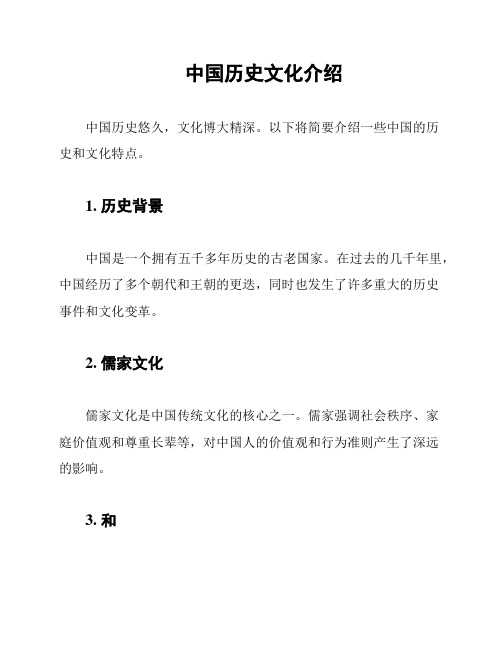
中国历史文化介绍
中国历史悠久,文化博大精深。
以下将简要介绍一些中国的历
史和文化特点。
1. 历史背景
中国是一个拥有五千多年历史的古老国家。
在过去的几千年里,中国经历了多个朝代和王朝的更迭,同时也发生了许多重大的历史
事件和文化变革。
2. 儒家文化
儒家文化是中国传统文化的核心之一。
儒家强调社会秩序、家
庭价值观和尊重长辈等,对中国人的价值观和行为准则产生了深远
的影响。
3. 和
除了儒家文化外,和也对中国的历史和文化产生了重要影响。
强调个体修行和追求长寿,而强调慈悲和处世哲学。
4. 传统节日
中国拥有丰富多样的传统节日,每个节日都有独特的庆祝方式和深厚的文化含义。
例如,春节是中国最重要的节日,人们会进行祭祖、拜年和放鞭炮等活动。
5. 中国书法和绘画
中国书法和绘画被视为中国文化的瑰宝。
书法被认为是艺术与文字的结合,而绘画以其独特的风格和主题吸引了全世界的关注。
6. 中医和功夫
中医和功夫是中国传统医药和武术的代表。
中医注重人体的整体平衡和自然治愈力,而功夫则是一种独特的武术形式,强调技巧和内心的平静。
7. 丝绸之路
丝绸之路是古代中国与其他文明交流的重要通道。
它不仅促进了经济和文化交流,还使中国成为了一个多元化和开放的国家。
在这份文档中,我们简要介绍了中国的历史和文化特点。
中国的历史悠久而丰富多样的文化给世界带来了无数的贡献和影响。
历史文化的传承与保护
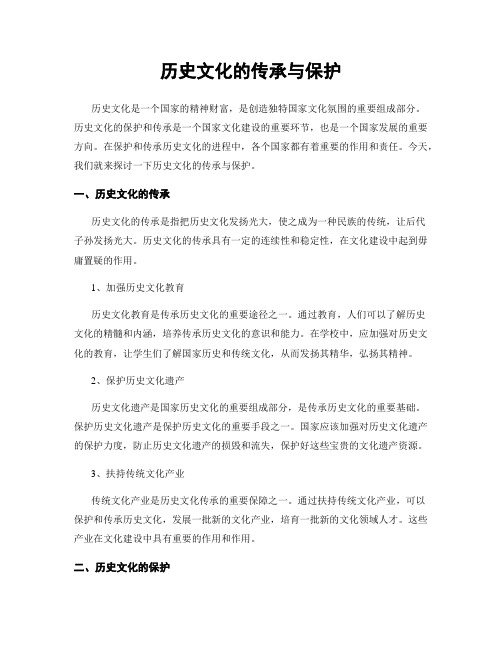
历史文化的传承与保护历史文化是一个国家的精神财富,是创造独特国家文化氛围的重要组成部分。
历史文化的保护和传承是一个国家文化建设的重要环节,也是一个国家发展的重要方向。
在保护和传承历史文化的进程中,各个国家都有着重要的作用和责任。
今天,我们就来探讨一下历史文化的传承与保护。
一、历史文化的传承历史文化的传承是指把历史文化发扬光大,使之成为一种民族的传统,让后代子孙发扬光大。
历史文化的传承具有一定的连续性和稳定性,在文化建设中起到毋庸置疑的作用。
1、加强历史文化教育历史文化教育是传承历史文化的重要途径之一。
通过教育,人们可以了解历史文化的精髓和内涵,培养传承历史文化的意识和能力。
在学校中,应加强对历史文化的教育,让学生们了解国家历史和传统文化,从而发扬其精华,弘扬其精神。
2、保护历史文化遗产历史文化遗产是国家历史文化的重要组成部分,是传承历史文化的重要基础。
保护历史文化遗产是保护历史文化的重要手段之一。
国家应该加强对历史文化遗产的保护力度,防止历史文化遗产的损毁和流失,保护好这些宝贵的文化遗产资源。
3、扶持传统文化产业传统文化产业是历史文化传承的重要保障之一。
通过扶持传统文化产业,可以保护和传承历史文化,发展一批新的文化产业,培育一批新的文化领域人才。
这些产业在文化建设中具有重要的作用和作用。
二、历史文化的保护历史文化的保护是指通过各种手段,防止历史文化的损毁和流失,以保护国家宝贵的历史文化遗产。
历史文化的保护应该从多角度进行,力图保护好每一个宝贵的历史文化遗产。
1、加强法律保护历史文化遗产的保护是一项长期而艰巨的工作,需要国家和社会的共同努力。
针对历史文化遗产的破坏、盗窃和损毁等行为,应加强法律保护,从法律层面保护历史文化遗产的安全。
2、科技保护科技手段在历史文化保护中发挥了很大的作用。
通过数字化和虚拟化等科技手段,可以对历史文化遗产进行保护和传承。
同时,通过科技保护,可以让更多的人了解和学习这些文化遗产。
历史文化知识
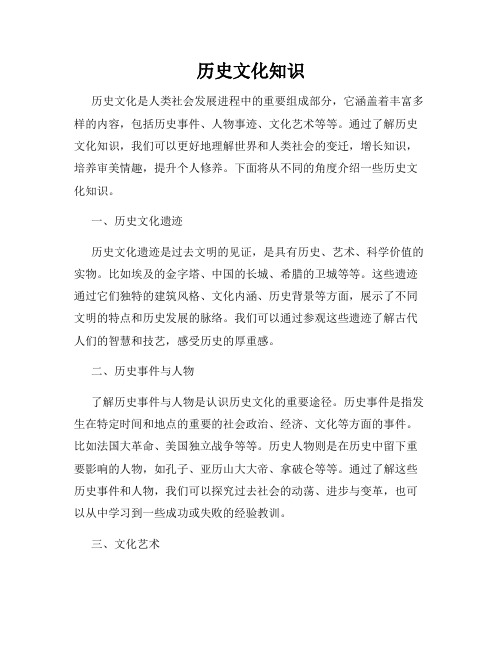
历史文化知识历史文化是人类社会发展进程中的重要组成部分,它涵盖着丰富多样的内容,包括历史事件、人物事迹、文化艺术等等。
通过了解历史文化知识,我们可以更好地理解世界和人类社会的变迁,增长知识,培养审美情趣,提升个人修养。
下面将从不同的角度介绍一些历史文化知识。
一、历史文化遗迹历史文化遗迹是过去文明的见证,是具有历史、艺术、科学价值的实物。
比如埃及的金字塔、中国的长城、希腊的卫城等等。
这些遗迹通过它们独特的建筑风格、文化内涵、历史背景等方面,展示了不同文明的特点和历史发展的脉络。
我们可以通过参观这些遗迹了解古代人们的智慧和技艺,感受历史的厚重感。
二、历史事件与人物了解历史事件与人物是认识历史文化的重要途径。
历史事件是指发生在特定时间和地点的重要的社会政治、经济、文化等方面的事件。
比如法国大革命、美国独立战争等等。
历史人物则是在历史中留下重要影响的人物,如孔子、亚历山大大帝、拿破仑等等。
通过了解这些历史事件和人物,我们可以探究过去社会的动荡、进步与变革,也可以从中学习到一些成功或失败的经验教训。
三、文化艺术文化艺术是历史文化的重要组成部分,通过它们可以了解一个民族的精神追求和审美观念。
比如中国的京剧、意大利的咏史歌剧等等。
这些艺术形式融合了语言、音乐、舞蹈、戏剧等艺术要素,通过表演艺术中独特的手法和技巧,展现了不同文化的独特魅力。
通过学习和欣赏这些艺术形式,我们可以享受到美的感受,丰富自己的精神世界。
四、历史文化对当代的影响历史文化不仅是过去的记忆,也对当代社会产生着重要影响。
通过历史文化的学习,我们可以吸取宝贵的教训,避免重蹈覆辙。
同时,历史文化也为我们提供了丰富的创造力和想象力的源泉。
当代许多文化创作都是源于对历史文化的解读与思考。
比如历史小说、历史电影等等。
这些作品通过对历史的演绎和再现,让我们更好地了解过去,同时也拓宽了我们的思维和视野。
结论:历史文化知识的了解对于我们个人的成长和社会的进步都具有重要的意义。
什么是历史文化范文

什么是历史文化范文历史文化是指一个国家、一个民族在其发展过程中所创造的历史和文化遗产。
它包含了一个社会的历史、传统、价值观念、习俗、艺术、语言等各个方面的内容。
历史文化反映了一个社会的发展进程,是人类智慧和创造力的结晶,是民族的精神财富。
历史文化是一个民族发展和进步的见证。
每个民族都有自己独特的历史和文化。
这些历史和文化记载了一个民族自古以来的演变和发展。
通过对历史文化的学习和研究,我们可以了解一个民族是如何从原始社会发展到现代社会的,了解其所经历的政治、经济和社会变迁,了解传统和现代的融合与冲突。
历史文化以其多元的视角和广泛的内容,为我们提供了一种独特的理解和认识世界的方式。
历史文化是一个民族的传承和象征。
历史文化是一个国家、一个民族的精神遗产,承载着其独特的文化记忆和认同。
通过对历史文化的传承,一个民族可以保持自己的独特性,加强对自身文化的认同感和归属感。
历史文化可以表达一个民族的特色和个性,使其在世界各国中独树一帜,展示其独特的风采和魅力。
历史文化是一个民族的文化自信。
历史文化是一个民族文化的源头和底蕴,是其自信心和自尊心的基石。
一个民族只有在自身文化的基础上拥有自信,才能与其他民族进行平等的交流和对话。
历史文化可以增强一个民族的文化自信心,鼓励其积极参与全球文化交流与互动。
只有在全球化的背景下,每个国家和民族都应该保持自己的独特性和差异性,才能实现文化多样性和文化平等的目标。
历史文化是一个民族的文化软实力。
历史文化是一个民族的软实力之一,具有很高的观赏性和吸引力。
通过对历史文化的展示和传播,一个民族可以吸引更多的人来关注其独特的文化,提高其在国际社会中的影响力和竞争力。
历史文化既可以提供人们愉悦的文化享受,也可以满足人们对于历史和传统文化的渴望。
历史文化通过各种艺术形式的表达,为人们提供了一种独特的审美体验和感受。
总之,历史文化是一个民族和社会的重要组成部分,它承载了一个民族的历史、记忆和文化认同。
历史文化知识点

历史文化知识点历史文化是指人类社会在不同历史时期所创造的物质和精神财富,包括历史事件、人物、文化遗产、传统习俗等。
历史文化知识点是指在学习历史文化时需要了解和掌握的重要知识要点。
本文将从不同的角度介绍一些历史文化知识点,帮助读者更好地了解和学习历史文化。
一、古代文明古代文明是人类历史上最早的文明形态,包括埃及文明、巴比伦文明、印度河文明、中国文明等。
这些文明在农业、手工业、政治制度、宗教信仰等方面都有独特的特点。
比如,埃及文明以尼罗河为中心,发展了灌溉农业和金字塔建筑;巴比伦文明以两河流域为中心,发展了法典和轮子;印度河文明以印度河流域为中心,发展了城市规划和铸造技术;中国文明以黄河和长江流域为中心,发展了文字和农业技术。
二、古代帝国古代帝国是指在古代时期出现的大型国家,由君主统治,领土广阔,政权稳定。
其中,埃及、巴比伦、波斯、希腊、罗马等文明古国都曾建立过强大的帝国。
这些帝国在政治、军事、文化等方面都有卓越的成就。
比如,罗马帝国以其强大的军事力量和先进的行政制度,统一了欧洲大部分地区,对后世的政治制度和法律产生了深远影响。
三、文化交流与融合历史上,不同文明之间的交流与融合是不可避免的。
这种交流与融合不仅促进了文化的繁荣,也推动了人类社会的发展。
比如,古代丝绸之路的开通,使东西方文明得以交流,带来了物质和文化的互通;欧洲文艺复兴时期,古希腊和古罗马文化的复兴对欧洲文化产生了深远影响。
四、历史人物历史人物是历史文化中的重要组成部分,他们的思想、行为和成就对后世产生了深远的影响。
比如,孔子是中国古代儒家学派的创始人,他的思想对中国和东亚地区产生了深远影响;亚历山大大帝是古希腊的伟大征服者,他的征服扩张使希腊文化传播到亚洲和非洲地区。
五、世界遗产世界遗产是指具有全球意义的自然和文化遗产,代表了人类文明的杰出成就。
联合国教科文组织设立了世界遗产名录,旨在保护和传承这些独特的遗产。
比如,埃及的金字塔、中国的长城、希腊的雅典卫城等都是世界遗产的代表。
什么是历史文化遗产?
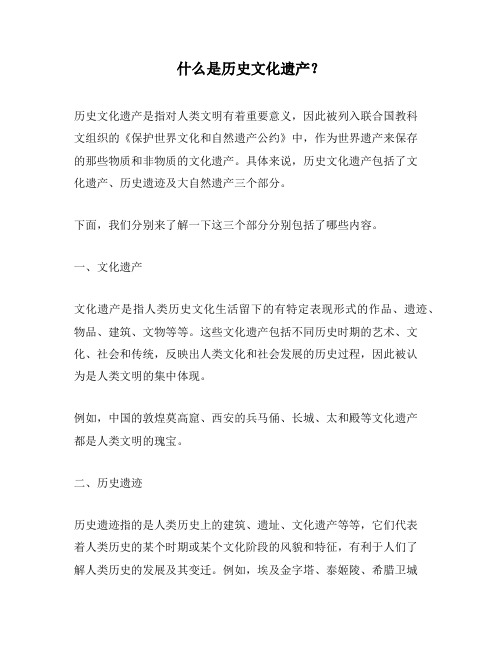
什么是历史文化遗产?历史文化遗产是指对人类文明有着重要意义,因此被列入联合国教科文组织的《保护世界文化和自然遗产公约》中,作为世界遗产来保存的那些物质和非物质的文化遗产。
具体来说,历史文化遗产包括了文化遗产、历史遗迹及大自然遗产三个部分。
下面,我们分别来了解一下这三个部分分别包括了哪些内容。
一、文化遗产文化遗产是指人类历史文化生活留下的有特定表现形式的作品、遗迹、物品、建筑、文物等等。
这些文化遗产包括不同历史时期的艺术、文化、社会和传统,反映出人类文化和社会发展的历史过程,因此被认为是人类文明的集中体现。
例如,中国的敦煌莫高窟、西安的兵马俑、长城、太和殿等文化遗产都是人类文明的瑰宝。
二、历史遗迹历史遗迹指的是人类历史上的建筑、遗址、文化遗产等等,它们代表着人类历史的某个时期或某个文化阶段的风貌和特征,有利于人们了解人类历史的发展及其变迁。
例如,埃及金字塔、泰姬陵、希腊卫城等等都是历史遗迹的代表。
三、大自然遗产大自然遗产是指大自然中的一些重要的自然现象和自然环境,例如特别美丽的风景、独特的生物群落、自然资源等等。
这些大自然遗产在形成上可能经历了长时间的演化和变化,因此具有重要的科学价值。
例如著名的大峡谷、黄石公园、阿尔卑斯山脉等大自然遗产都是代表了不同生态系统的珍贵资源。
历史文化遗产既是人类文明的精髓,也是世界文化遗产的重要组成部分。
保护历史文化遗产对于继承人类灿烂文明的历程具有重大的意义。
我们每个人都应该追求文化遗产保护,在自己的力所能及的范围内,为世界文明和历史贡献自己的一份力量。
历史文化简介

历史文化简介中国拥有悠久而丰富的历史文化,其灿烂的辉煌影响着世界各地。
从古代的建筑至传统的习俗,中国的历史文化蕴含着深厚的智慧和独特的魅力。
本文章将为您提供对中国历史文化的简单介绍,展示其独特之处。
一、中国古代建筑艺术中国古代建筑艺术是中华文明的重要组成,代表了中国古人聪明智慧及其对自然的崇敬。
它通过独特的工艺与风格,展示了中国人民坚韧不拔的性格及其对美的追求。
中国古代建筑以其气势恢宏和博大精深而闻名于世。
中国古代建筑以宫殿和庙宇为代表,其中最出名的是北京的故宫和陕西的秦始皇兵马俑。
故宫作为世界上保存最完整的古代宫殿群,向世人展示了中国帝王的尊贵与权力。
而兵马俑则是中国古代的绝世奇迹,因其数量众多、形象逼真而震撼了世界。
二、传统节日与习俗中国拥有丰富多彩的传统节日,每个节日都有其独特的庆祝方式和含义。
春节是中国最重要的传统节日,它标志着农历新年的开始。
人们举行庆祝活动,包括舞龙舞狮、燃放烟花爆竹和家庭聚会等。
此外,中秋节也是中国传统节日之一,人们会分享月饼、赏月和举行各种民俗活动。
中国的习俗也是其独特文化的一部分。
例如,红色在中国文化中被视为幸运和吉祥的象征,因此在庆祝活动中经常使用红色。
婚礼中,新人和客人会穿着红色的装束,以表达对幸福和祝福的期望。
此外,茶文化在中国也非常重要,茶叶被视为连接人与自然的纽带,具有净化身心、提神醒脑的功效。
三、中国书法与绘画中国书法与绘画是中国艺术中最重要的两个方面,代表了中国人民对美的追求与独特的表达方式。
中国书法以其独特的字体和线条表现出无穷的美感,被誉为“东方之艺术瑰宝”。
中国绘画则以传统的山水画、花鸟画和人物画闻名于世。
这些作品注重意境的表达,追求“意境超然,笔墨灵动”的境界。
四、中国传统医学中国传统医学源远流长,被视为中国人民智慧的结晶。
中医的核心理念是“治未病”,强调保持身体的平衡和预防疾病。
中医包括草药疗法、针灸疗法和推拿疗法等,通过刺激人体的特定穴位来调节气血运行,以达到治疗疾病和提高身体健康的效果。
历史与文化的相互关系
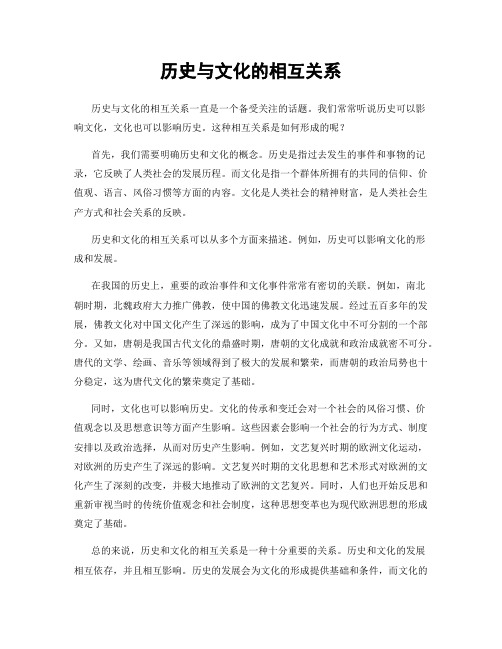
历史与文化的相互关系历史与文化的相互关系一直是一个备受关注的话题。
我们常常听说历史可以影响文化,文化也可以影响历史。
这种相互关系是如何形成的呢?首先,我们需要明确历史和文化的概念。
历史是指过去发生的事件和事物的记录,它反映了人类社会的发展历程。
而文化是指一个群体所拥有的共同的信仰、价值观、语言、风俗习惯等方面的内容。
文化是人类社会的精神财富,是人类社会生产方式和社会关系的反映。
历史和文化的相互关系可以从多个方面来描述。
例如,历史可以影响文化的形成和发展。
在我国的历史上,重要的政治事件和文化事件常常有密切的关联。
例如,南北朝时期,北魏政府大力推广佛教,使中国的佛教文化迅速发展。
经过五百多年的发展,佛教文化对中国文化产生了深远的影响,成为了中国文化中不可分割的一个部分。
又如,唐朝是我国古代文化的鼎盛时期,唐朝的文化成就和政治成就密不可分。
唐代的文学、绘画、音乐等领域得到了极大的发展和繁荣,而唐朝的政治局势也十分稳定,这为唐代文化的繁荣奠定了基础。
同时,文化也可以影响历史。
文化的传承和变迁会对一个社会的风俗习惯、价值观念以及思想意识等方面产生影响。
这些因素会影响一个社会的行为方式、制度安排以及政治选择,从而对历史产生影响。
例如,文艺复兴时期的欧洲文化运动,对欧洲的历史产生了深远的影响。
文艺复兴时期的文化思想和艺术形式对欧洲的文化产生了深刻的改变,并极大地推动了欧洲的文艺复兴。
同时,人们也开始反思和重新审视当时的传统价值观念和社会制度,这种思想变革也为现代欧洲思想的形成奠定了基础。
总的来说,历史和文化的相互关系是一种十分重要的关系。
历史和文化的发展相互依存,并且相互影响。
历史的发展会为文化的形成提供基础和条件,而文化的传承和发展也会推动历史的发展和进步。
历史和文化的相互影响,是一个不断发展和演变的过程,这种关系必须得到更好的理解和重视。
中国历史值得传承的文化

中国历史值得传承的文化
中国历史悠久,文化底蕴深厚,其中有很多值得传承的文化。
以下是一些建议:
1. 汉字:汉字是中华文明的基础,已有几千年的历史。
它具有高度的规范性和灵活性,是中华民族智慧和智慧的结晶。
2. 中华文化:中华文化包括哲学、文学、艺术、哲学、宗教、礼仪等方面的内容。
它体现了中华民族的精神风貌和价值观,是中华民族共同的精神家园。
3. 诗词歌赋:诗词歌赋是中国古代文学的瑰宝,它们反映了中华民族丰富的历史、文化和思想。
其中,唐诗、宋词、元曲、明清小说等,都是中国文学的瑰宝。
4. 传统工艺:中国传统工艺包括绘画、雕刻、书法、剪纸、编织、刺绣、制作等。
它们是中华民族传统智慧的结晶,具有很高的艺术价值和历史价值。
5. 中医:中医是中国古代医学的瑰宝,已有几千年的历史。
它具有系统的理论体系和实践经验,对中华民族的身体健康和生命健康具有重要的意义。
6. 儒家思想:儒家思想是中国传统文化的核心,强调仁爱、忠诚、礼仪、责任等价值观。
它对中华民族的道德观念和社会风气产生了深远的影响。
7. 民间艺术:民间艺术包括民间舞蹈、音乐、戏剧、曲艺、民间美术等。
它们反映了中华民族的民间智慧和创造力,是中华民族文化的重要组成部分。
8. 现代文化:随着现代社会的进步,现代文化逐渐崛起。
例如,电影、音乐、动漫、新媒体等,它们具有很高的艺术价值和历史价值,也是中华民族现代文明的重要组成部分。
总之,中国历史值得传承的文化非常丰富多样,它们都是中华民族文明的重要组成部分。
我们应该珍惜和传承这些文化,让它们继续为中华民族的繁荣和发展做出贡献。
我国历史文化常识大全

我国历史文化常识大全中国历史悠久,文化底蕴深厚。
下面将为您介绍一些我国历史文化的常识,希望能够增加您的知识储备和了解我国丰富的文化遗产。
一、中华文化源远流长中华文化的历史可追溯到5000多年前的仰韶文化时期。
在此期间,中国人民创造了彩陶、龙纹璧等众多文物,展示了中华文明的开端。
二、中国的四大发明中国古代有四大发明,分别是造纸术、印刷术、火药和指南针。
这些发明为人类社会的进步作出了巨大贡献,也是中国古代科技的杰出代表。
三、中华民族的三大礼仪中华民族的三大礼仪是:九族大典、仪礼和周礼。
这些礼仪体系建立了独特的礼仪文化,加强了社会秩序,凝聚了中华民族的精神核心。
四、中国古代封建社会中国古代历经夏、商、周三代,形成了封建社会。
封建社会在政治、经济、文化等方面都有其独特的体制和特点,为中国古代历史的发展奠定了基础。
五、中国古代的科举制度科举制度是中国古代的一项选拔人才的考试制度。
通过科举考试,人们可以获得功名和地位,这种制度在中国历史上长期存在,对中国社会的发展有重要影响。
六、中国古代的四书五经四书五经是中国古代的经典著作,包括四书:《大学》、《中庸》、《论语》和《孟子》,以及五经:《诗经》、《尚书》、《礼记》、《周易》和《春秋》。
这些经典被视为中国古代思想文化的重要遗产。
七、中国古代的建筑艺术中国古代的建筑艺术以其特殊的风格和独特的构造技术而闻名。
例如,中国的宫殿建筑具有严谨的布局和宏伟的气势,寺庙和园林则展示了中国人对自然的追求和审美情趣。
八、中国的传统节日中国有许多丰富多彩的传统节日,如春节、清明节、端午节、中秋节等。
这些传统节日与中国人民的生活息息相关,体现了中华民族的文化传统和精神价值观。
九、中国的书法和绘画艺术中国书法和绘画艺术是中国传统文化的重要组成部分。
中国书法注重笔画的墨色和构图,绘画则以山水画和花鸟画为代表,追求意境的表现和审美的内涵。
十、中国的音乐和舞蹈中国音乐和舞蹈以其独特的风格和和谐的美感而闻名。
中国古代历史文化介绍(精选5篇)
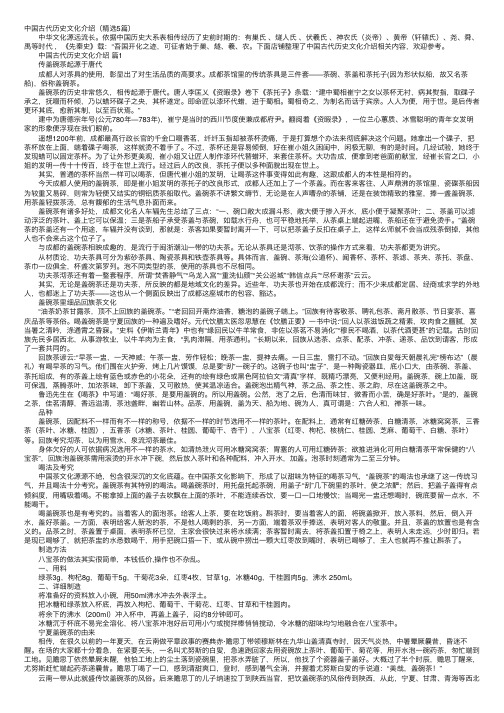
中国古代历史⽂化介绍(精选5篇) 中华⽂化源远流长。
依据中国历史⼤系表相传经历了史前时期的:有巢⽒、燧⼈⽒、伏羲⽒、神农⽒(炎帝)、黄帝(轩辕⽒)、尧、舜、禹等时代,《先秦史》载:“吾国开化之迹,可征者始于巢、燧、羲、农。
下⾯店铺整理了中国古代历史⽂化介绍相关内容,欢迎参考。
中国古代历史⽂化介绍篇1 传盖碗茶起源于唐代 成都⼈对茶具的使⽤,彰显出了对⽣活品质的⾼要求。
成都茶馆⾥的传统茶具是三件套——茶碗、茶盖和茶托⼦(因为形状似船,故⼜名茶船),俗称盖碗茶。
盖碗茶的历史⾮常悠久,相传起源于唐代。
唐⼈李匡乂《资暇录》卷下《茶托⼦》条载:“建中蜀相崔宁之⼥以茶杯⽆衬,病其熨指,取碟⼦承之,抚啜⽽杯倾,乃以蜡环碟⼦之央,其杯遂定。
即命匠以漆环代蜡,进于蜀相。
蜀相奇之,为制名⽽话于宾亲。
⼈⼈为便,⽤于世。
是后传者更环其底,愈新其制,以⾄百状焉。
” 建中为唐德宗年号(公元780年—783年),崔宁是当时的西川节度使兼成都府尹。
翻阅着《资暇录》,⼀位兰⼼蕙质、冰雪聪明的青年⼥发明家的形象便浮现在我们眼前。
遥想1200年前,成都最⾼⾏政长官的千⾦⼝啜⾹茗,纤纤⽟指却被茶杯烫痛,于是打算想个办法来彻底解决这个问题。
她拿出⼀个碟⼦,把茶杯放在上⾯,端着碟⼦喝茶,这样就烫不着⼿了。
不过,茶杯还是容易倾倒,好在崔⼩姐久困闺中,闲极⽆聊,有的是时间。
⼏经试验,她终于发现蜡可以固定茶杯。
为了让外形更美观,崔⼩姐⼜让匠⼈制作漆环代替蜡环,来套住茶杯。
⼤功告成,便拿到⽼爸⾯前献宝,经崔长官之⼝,⼩姐的发明⼀传⼗⼗传百,终于在世上流⾏。
经过后⼈的改良,茶托⼦便以多种⾯貌出现在世上。
其实,普通的茶杯当然⼀样可以喝茶,但唐代崔⼩姐的发明,让喝茶这件事变得如此有趣,这跟成都⼈的本性是相符的。
今天成都⼈使⽤的盖碗茶,即是崔⼩姐发明的茶托⼦的改良形式,成都⼈还加上了⼀个茶盖。
⽽在客来客往、⼈声⿍沸的茶馆⾥,瓷碟茶船因为较重⼜易碎,则常为轻便⼜结实的铜铝质茶船取代。
探索历史文化的魅力
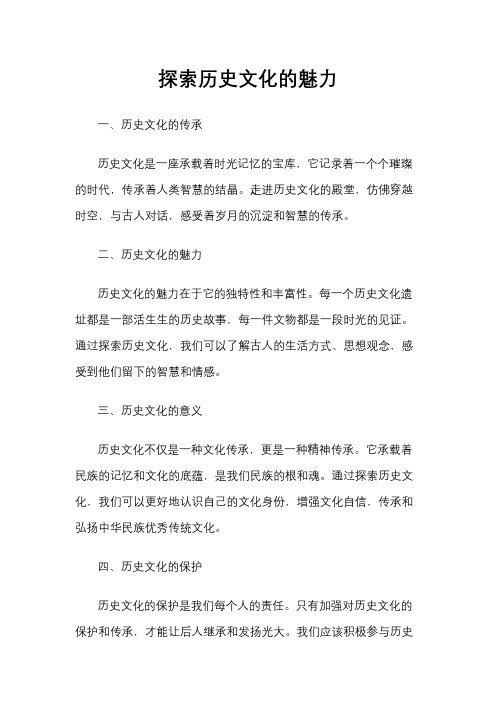
探索历史文化的魅力
一、历史文化的传承
历史文化是一座承载着时光记忆的宝库,它记录着一个个璀璨的时代,传承着人类智慧的结晶。
走进历史文化的殿堂,仿佛穿越时空,与古人对话,感受着岁月的沉淀和智慧的传承。
二、历史文化的魅力
历史文化的魅力在于它的独特性和丰富性。
每一个历史文化遗址都是一部活生生的历史故事,每一件文物都是一段时光的见证。
通过探索历史文化,我们可以了解古人的生活方式、思想观念,感受到他们留下的智慧和情感。
三、历史文化的意义
历史文化不仅是一种文化传承,更是一种精神传承。
它承载着民族的记忆和文化的底蕴,是我们民族的根和魂。
通过探索历史文化,我们可以更好地认识自己的文化身份,增强文化自信,传承和弘扬中华民族优秀传统文化。
四、历史文化的保护
历史文化的保护是我们每个人的责任。
只有加强对历史文化的保护和传承,才能让后人继承和发扬光大。
我们应该积极参与历史
文化的保护工作,保护好每一个历史文化遗址,传承好每一件珍贵的文物,让历史文化的魅力永远流传下去。
五、结语
探索历史文化的魅力,就是在寻找自己的根和魂,感受古人的智慧和情感,传承民族的文化底蕴。
让我们一起走进历史文化的殿堂,感受历史的魅力,传承文化的力量,让历史文化的光芒永远照耀着我们的心灵。
历史文化的重要意义和价值

历史文化的重要意义和价值历史文化是指一个国家、一个民族、一个地区或一个人的过去;文化是指一个民族、一个地区或一个人的社会伦理品质、道德约束、生态环境、文化繁荣等等。
历史文化的重要意义和价值,主要表现在以下三个方面:对于人类文明的发展、对于国家、民族和社会的发展、对于一个人的成长和发展。
历史文化对于人类文明的发展起着重要的作用。
历史文化是人类文明的产物,历史文化的产生、发展与演变是人类文明发展的重要组成部分。
历史文化不仅反映了人类社会的思想、信仰、艺术、科技等方面的水平,同时也呈现出人类文明的多样性和丰富性。
通过对历史文化进行研究和探讨,能够更加深入地了解人类的过去,对于人类文明的发展具有积极的推动作用。
历史文化对于国家、民族和社会的发展同样具有巨大的意义和价值。
历史文化包括了一个国家、一个民族和一个社会的多种方面,如宗教信仰、文化传统、艺术技巧、文学语言、科学知识等等。
这些方面的文化积淀,不能脱离上下文环境进行考察和解析。
通过对历史文化的研究,我们可以看到一个国家、一个民族和一个社会的渐进性发展历程,了解到历史上社会制度、政治理论、文化传播等的变化和演变,更加深刻地了解一个国家或民族的文化特点,有利于为这个国家或民族的发展赋能。
历史文化对于一个人的成长和发展也有着重要的启示意义。
一个人的成长和发展是建立在传统文化基础上的。
通过对历史文化的学习,一个人能够了解自己的传统文化,知晓自己民族的文化传统、价值观念和生活方式,进而塑造自己的独特价值观,提升自我修养和思考能力。
同时,也能够更加深入地了解人类历史的发展演变,有助于坚持正确的人生观和发展观,在生活和工作中能够更好地融入到社会,成就自己。
总之,历史文化具有重要的意义和价值。
通过对历史文化的研究和探索,能够更加深入地了解人类文明的发展历程和多样性,发掘这些文化穿越历史的奇妙之处,有助于我们把握社会主流,正确引导人们的思想和行为。
同时,历史文化对于国家、民族和社会的发展同样具有深远的启示意义,我们应该珍惜历史文化,深入学习和探索,推动历史文化的保护和发展。
历史历史文化
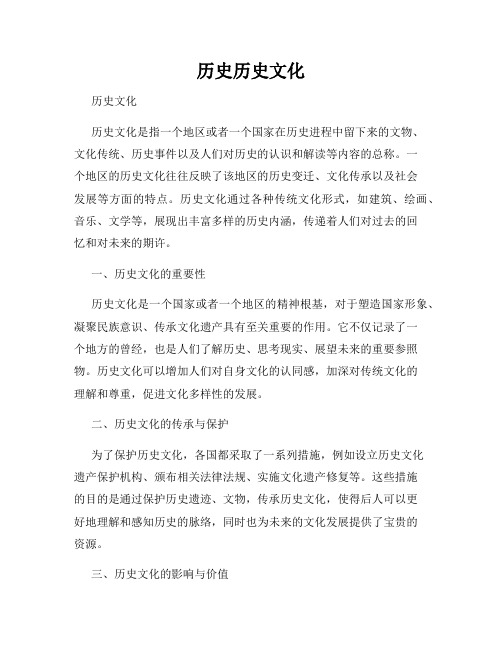
历史历史文化历史文化历史文化是指一个地区或者一个国家在历史进程中留下来的文物、文化传统、历史事件以及人们对历史的认识和解读等内容的总称。
一个地区的历史文化往往反映了该地区的历史变迁、文化传承以及社会发展等方面的特点。
历史文化通过各种传统文化形式,如建筑、绘画、音乐、文学等,展现出丰富多样的历史内涵,传递着人们对过去的回忆和对未来的期许。
一、历史文化的重要性历史文化是一个国家或者一个地区的精神根基,对于塑造国家形象、凝聚民族意识、传承文化遗产具有至关重要的作用。
它不仅记录了一个地方的曾经,也是人们了解历史、思考现实、展望未来的重要参照物。
历史文化可以增加人们对自身文化的认同感,加深对传统文化的理解和尊重,促进文化多样性的发展。
二、历史文化的传承与保护为了保护历史文化,各国都采取了一系列措施,例如设立历史文化遗产保护机构、颁布相关法律法规、实施文化遗产修复等。
这些措施的目的是通过保护历史遗迹、文物,传承历史文化,使得后人可以更好地理解和感知历史的脉络,同时也为未来的文化发展提供了宝贵的资源。
三、历史文化的影响与价值历史文化对于社会的影响和价值是多维的。
首先,历史文化可以为社会提供智慧。
通过对历史事件和历史人物的研究,人们可以吸取历史经验教训,为社会发展提供重要的参考。
其次,历史文化可以促进人类对自身价值的认同。
历史文化作为一种精神遗产,使得人们形成自己的文化身份。
最后,历史文化对于文化产业的发展也具有重要意义。
通过对历史题材的文化创意和创新,可以激发文化产业的活力,推动文化产业的繁荣发展。
四、历史文化旅游的推动作用历史文化旅游是一种融合了旅游、文化、历史于一体的旅游形式,它以历史文化为核心内容,为游客提供了了解和体验历史文化的机会。
历史文化旅游不仅可以满足人们对美的追求和享受旅行带来的乐趣,更重要的是可以推动当地经济的发展和历史文化的保护。
通过历史文化旅游,游客可以深入了解一个地方的历史文化,增加对历史的认知,在游玩的过程中在潜移默化中收获知识。
中国历史文化知识要点
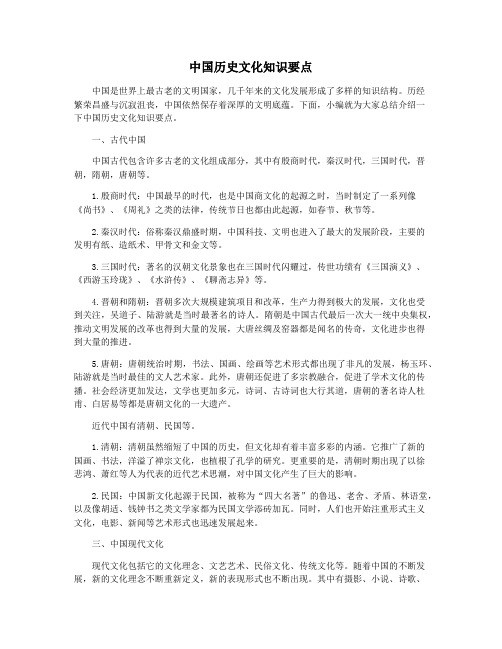
中国历史文化知识要点中国是世界上最古老的文明国家,几千年来的文化发展形成了多样的知识结构。
历经繁荣昌盛与沉寂沮丧,中国依然保存着深厚的文明底蕴。
下面,小编就为大家总结介绍一下中国历史文化知识要点。
一、古代中国中国古代包含许多古老的文化组成部分,其中有殷商时代,秦汉时代,三国时代,晋朝,隋朝,唐朝等。
1.殷商时代:中国最早的时代,也是中国商文化的起源之时,当时制定了一系列像《尚书》、《周礼》之类的法律,传统节日也都由此起源,如春节、秋节等。
2.秦汉时代:俗称秦汉鼎盛时期,中国科技、文明也进入了最大的发展阶段,主要的发明有纸、造纸术、甲骨文和金文等。
3.三国时代:著名的汉朝文化景象也在三国时代闪耀过,传世功绩有《三国演义》、《西游玉玲珑》、《水浒传》、《聊斋志异》等。
4.晋朝和隋朝:晋朝多次大规模建筑项目和改革,生产力得到极大的发展,文化也受到关注,吴道子、陆游就是当时最著名的诗人。
隋朝是中国古代最后一次大一统中央集权,推动文明发展的改革也得到大量的发展,大唐丝绸及窑器都是闻名的传奇,文化进步也得到大量的推进。
5.唐朝:唐朝统治时期,书法、国画、绘画等艺术形式都出现了非凡的发展,杨玉环、陆游就是当时最佳的文人艺术家。
此外,唐朝还促进了多宗教融合,促进了学术文化的传播。
社会经济更加发达,文学也更加多元,诗词、古诗词也大行其道,唐朝的著名诗人杜甫、白居易等都是唐朝文化的一大遗产。
近代中国有清朝、民国等。
1.清朝:清朝虽然缩短了中国的历史,但文化却有着丰富多彩的内涵。
它推广了新的国画、书法,洋溢了禅宗文化,也植根了孔学的研究。
更重要的是,清朝时期出现了以徐悲鸿、萧红等人为代表的近代艺术思潮,对中国文化产生了巨大的影响。
2.民国:中国新文化起源于民国,被称为“四大名著”的鲁迅、老舍、矛盾、林语堂,以及像胡适、钱钟书之类文学家都为民国文学添砖加瓦。
同时,人们也开始注重形式主义文化,电影、新闻等艺术形式也迅速发展起来。
中国历史重大文化有哪些

中国历史重大文化有哪些中国是一个历史悠久的国家,自古以来就有着灿烂的文化传统。
在漫长的历史长河中,中国历代创造了许多重大的文化,这些文化财富丰富多彩,非常独特,现在依然对人们产生着深远的影响。
那么,中国历史上有哪些重大文化呢?下面我将简要介绍几个。
1. 古代哲学思想中国古代哲学思想是世界上非常重要的一种思想体系,其中包括儒家、道家和墨家等思想流派。
儒家思想强调人的道德修养和行为规范,提倡“仁爱”和“礼治”,推崇孔子、孟子等人;道家思想则讲究自然和谐,主张放弃功利心和欲望,贵在性情和自由,提倡道教和养生学说,推崇老子、庄子等人;而墨家则强调实用主义和平等主义,提倡以实际效果和社会公益为导向,反对战争和剥削,推崇墨子、荀子等人。
这些思想在中国历史上具有重要的影响和地位,可以说是中国智慧和文化的精髓所在。
2. 诗词文学中国诗词文学是一个古老而独特的文学体系,可以追溯到古代诗经、楚辞、唐诗、宋词等。
这些作品有着丰富多彩的题材,反映着中国人民的思想道德和社会风貌,许多作品都被传颂千古,成为中国文化的瑰宝。
诗歌是中国文学里最为典型的表现形式,它有着精湛的艺术价值和深刻的思想内涵,是中外文化交流和人类文化的宝库。
3. 历史文物中国历史文物是中国文化史上具有重要纪念和历史价值的物品,可分为器物、建筑、书画、佛教、主要史料等。
在中国历史上,曾经拥有过庞大的文化遗产,例如长城、故宫、太和殿、鼓楼等众多高大的建筑物,都代表着中国历史上的文化高峰。
书画作品是中国文化史上的重要组成部分,它们都具有深刻的艺术价值和极高的历史价值。
4. 丝绸之路丝绸之路是中国历史上极为重要的一条商业路线,在古代就已经存在。
这条路线是中国和各种文明世界之间的交流和贸易平台,也是东西方文化相遇的场所。
在丝绸之路上,中国向世界传递了自己的文化,也开启了外交和经贸领域的路线,起到了重要的历史作用和影响。
总之,中国历史上有着丰富多彩的文化遗产,这些文化对中国的发展和影响都是非常深远的。
历史文化的分类与定义

历史文化的分类与定义历史文化是广义上的概念,其涵盖面极广。
人类从古至今所留下来的文化遗产,包括历史文化、自然文化、物质文化等多种类型,但其内核都是通过社会演化和传承所产生和发展起来。
如何对历史文化进行分类和定义,是一个非常复杂而又意义重大的问题。
一、历史文化的分类方式1、按时间分类按时间分类是历史文化最基本、最常见的分类方式。
按时间范围可分为远古文化、古代文化、近代文化和现代文化。
远古文化通常是指史前文化,古代文化则包括古希腊文化、古罗马文化、中世纪文化等,近代文化包括文艺复兴文化、工业革命文化、启蒙文化等,而现代文化则包括当今的各种文化。
2、按空间范围分类按空间范围分类是指将历史文化按所在地区的空间范围进行分类。
可以分为西方文化和东方文化等,但同一地域内不同地区也具有各自独特的文化。
3、按内容分类按内容分类则是指将历史文化按其包含的主题进行分类,如宗教文化、哲学文化、文学文化、音乐文化、体育文化等。
二、历史文化的定义历史文化是在历史时间长河中形成的文化现象,包括了人类社会的历史、文化、艺术、宗教、道德、信息、创造力等方面。
它是过去人类经验、思想、行为和所创造的一切文化遗产的集合。
历史文化以其自身的特征和价值,成为人类创造发展历程中不可或缺的元素,在当今世界流传不衰,影响深远。
1、包容性。
历史文化具有包容性,可以容纳并吸纳不同种族、不同民族的文化成分,进而发展演变出新的文化。
互相融合,共同进步。
2、多元化。
受到社会结构、地理环境、人口、文化删除等多方面条件的影响,人类文化呈现多元化。
文化多元化带来了丰富的人类文化,人们通过文化交流的方式互相学习,进而促进了人类文化的发展。
历史文化是人类智慧和灵魂的结晶,不仅是人类文明的组成部分,更是人类思想意识的表现形式。
如今,许多精神、智慧和价值观在历史文化中延续流传。
因此,保护、发扬和传承历史文化,可以使人类更好地认识过去,了解现在,面对未来。
不仅如此,历史文化还会为人类的未来发展提供精神食粮,激发人们拓展思维、追求创新的动力。
中国的历史文化
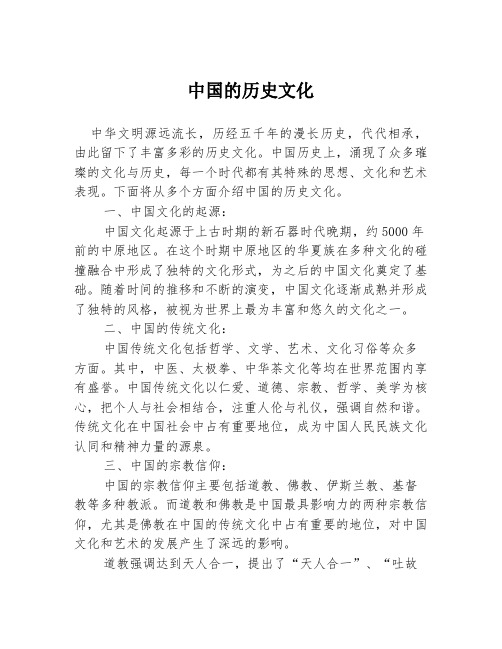
中国的历史文化中华文明源远流长,历经五千年的漫长历史,代代相承,由此留下了丰富多彩的历史文化。
中国历史上,涌现了众多璀璨的文化与历史,每一个时代都有其特殊的思想、文化和艺术表现。
下面将从多个方面介绍中国的历史文化。
一、中国文化的起源:中国文化起源于上古时期的新石器时代晚期,约5000年前的中原地区。
在这个时期中原地区的华夏族在多种文化的碰撞融合中形成了独特的文化形式,为之后的中国文化奠定了基础。
随着时间的推移和不断的演变,中国文化逐渐成熟并形成了独特的风格,被视为世界上最为丰富和悠久的文化之一。
二、中国的传统文化:中国传统文化包括哲学、文学、艺术、文化习俗等众多方面。
其中,中医、太极拳、中华茶文化等均在世界范围内享有盛誉。
中国传统文化以仁爱、道德、宗教、哲学、美学为核心,把个人与社会相结合,注重人伦与礼仪,强调自然和谐。
传统文化在中国社会中占有重要地位,成为中国人民民族文化认同和精神力量的源泉。
三、中国的宗教信仰:中国的宗教信仰主要包括道教、佛教、伊斯兰教、基督教等多种教派。
而道教和佛教是中国最具影响力的两种宗教信仰,尤其是佛教在中国的传统文化中占有重要的地位,对中国文化和艺术的发展产生了深远的影响。
道教强调达到天人合一,提出了“天人合一”、“吐故纳新”、“无为而治”等重要思想;佛教则注重修行、悟道和解脱,主张八正道、四圣谛和六度等宗教教义。
两种宗教信仰相辅相成、相互影响,为中国文化增添了许多宗教元素。
四、中国的音乐舞蹈:中国传统音乐艺术可以追溯至新石器时代晚期。
中国的音乐包括器乐、民间音乐、戏曲音乐和宗教音乐等多种类型。
其中,中国古典音乐是中国文化和音乐史上的重要组成部分,昆曲、京剧等戏曲则是中国文化艺术中的一大亮点,在世界舞台上享有盛誉。
中国汉族民间舞蹈由古至今,历经千载,独具特色。
舞蹈形式自古以来逐渐发展为华夏舞蹈、宗教舞蹈、民间舞蹈,表达出了中国人民对生命、自然、美好生活的向往和追求。
舞蹈形式繁多,各具特色,每种舞蹈都有其特殊的文化背景与象征意义。
历史文化的教育价值与意义
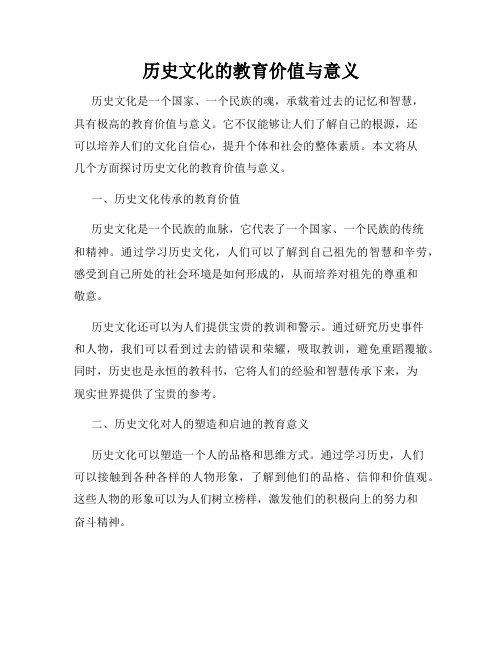
历史文化的教育价值与意义历史文化是一个国家、一个民族的魂,承载着过去的记忆和智慧,具有极高的教育价值与意义。
它不仅能够让人们了解自己的根源,还可以培养人们的文化自信心,提升个体和社会的整体素质。
本文将从几个方面探讨历史文化的教育价值与意义。
一、历史文化传承的教育价值历史文化是一个民族的血脉,它代表了一个国家、一个民族的传统和精神。
通过学习历史文化,人们可以了解到自己祖先的智慧和辛劳,感受到自己所处的社会环境是如何形成的,从而培养对祖先的尊重和敬意。
历史文化还可以为人们提供宝贵的教训和警示。
通过研究历史事件和人物,我们可以看到过去的错误和荣耀,吸取教训,避免重蹈覆辙。
同时,历史也是永恒的教科书,它将人们的经验和智慧传承下来,为现实世界提供了宝贵的参考。
二、历史文化对人的塑造和启迪的教育意义历史文化可以塑造一个人的品格和思维方式。
通过学习历史,人们可以接触到各种各样的人物形象,了解到他们的品格、信仰和价值观。
这些人物的形象可以为人们树立榜样,激发他们的积极向上的努力和奋斗精神。
同时,历史文化还可以启迪人们的智慧和思考。
历史上的智者和哲人们留下了许多深刻的言论和思想,这些思想可以帮助人们更好地理解人生和世界的意义,引导人们正确的生活态度和价值取向。
三、历史文化对社会的教育价值与意义历史文化的教育价值不仅仅体现在个体层面,它还对整个社会产生积极的影响。
首先,历史文化可以增强社会的凝聚力和认同感。
当人们了解自己国家、民族的历史文化时,他们会更加热爱自己所属的社会群体,形成一种共同的价值观和文化认同,从而凝聚人们的力量,推动社会的稳定和繁荣。
此外,历史文化也可以培养人们的国际视野和多元文化意识。
历史上的各个国家和民族都有着丰富多样的文化遗产,通过学习这些历史文化,人们可以更好地理解其他国家和民族,增进国际友谊和文化交流。
结语历史文化具有丰富的教育价值与意义,它可以传承、塑造和启迪人们,提升社会的整体素质和文化水平。
- 1、下载文档前请自行甄别文档内容的完整性,平台不提供额外的编辑、内容补充、找答案等附加服务。
- 2、"仅部分预览"的文档,不可在线预览部分如存在完整性等问题,可反馈申请退款(可完整预览的文档不适用该条件!)。
- 3、如文档侵犯您的权益,请联系客服反馈,我们会尽快为您处理(人工客服工作时间:9:00-18:30)。
第五章历史文化Ⅰ. Translate the following sentences into Chinese. Pay special attention to the italicized words.1. The manager sat in his office amid his morning mail.2. He is a man above vulgar interests.3. The ancient compass is of high sensibility.4. It looks as if we are in for a storm.5. He was between sheets by eleven.6. On a third voyage in 1498 Columbus found Trinidad and explored the northern coast of South America.7. Fresh from his role in Titanic, he has a double starring role in The Man in the Iron Mask.(《铁面人》)8. Later when the children came home for the week of Christmas, the house was bright with Christmas colours.9. He continued to search through the Bahamian Cays down to Cuba, a place name which suggested Cipangu (Japan), and then eastward to the island he named Espanola.10. Out of all the glorious tales written about the U. S. revolution for independence from Britain, the fact is hardly known that a black man was the first to die for American independence.Ⅱ. Translate the following sentences into English. Pay special attention to the underlined words.1.中国经历了一系列艰苦的变革和试验。
2.我再向外看时,他已抱了朱红的橘子往回走。
3.1292年,马可波罗携弟弟和儿子,随十四条大船组成的船队和六百名船员从中国南方一个港口出发,离开中国,前往威尼斯。
4.爹上班去了,妹不在家,妈刚找到工作,还得过一小时才下班。
5.经过仔细研究,他们发现这个设计落后了。
6.“来啦!”她转身蹦着跳着跑了,越过草地,跑上小径,跨上台阶,穿过阳台,进了门廊。
7.他们一不会做工,二不会种地,三不全打仗。
8.他们派了一个杀手去追杀他。
9.他们立刻出动去追击敌人。
10.我进屋时,他在读书。
Ⅲ. Translate the following passage into Chinese.Born in 1451, the son of an Italian weaver, Christopher Columbus took to the sea at an early age, making up for his lack of formal education by teaching himself geography, navigation, and Latin. By the 1480s Columbus -- a tall, red-haired, long-faced man with a ruddy complexion, oval eyes, and a prominent nose -- was an experienced seaman. Dazzled by the prospect of Asian riches, he hatched a scheme to reach the Indies (India, China, the East Indies, or Japan) by sailing west. After the courts of Portugal, England, and France showed little interest in his plan, Columbus turned to Spain for backing. He won the support of Ferdinand and Isabella, the Spanish monarchs, and himself raised much of the money needed to finance the voyage. The legend that the queen had to hock the crown jewels is as spurious as the fable that Columbus set out to prove the earth was round.Columbus chartered one seventy-five-foot ship, the Santa Maria, and the Spanish city of Palos supplied two smaller caravels, the Pinta and Nina. From Palos this little squadron, with eighty-seven officers and men, set sail westward for what Columbus thought was Asia. The first leg of the journey went well, thanks to a strong trade wind. But then the breeze lagged, the days passed, and the crew began to grumble about their captain's farfetched plan. To rally flagging morale, he reminded the crew of the dazzling riches awaiting them. Yet skepticism remained rife, and he finally promised that the expedition would mm back if land were not sighted in three days.Early on October 12, 1492, after thirty-three days at sea, a lookout on the Santa Maria yelled "Tierra ! Tierra ! [ Land ! Land ! ]" It was an island in the Bahamas that Columbus named San Salvador (Blessed Savior). According to Columbus's own reckoning he was near the Indies, so he called the island people los Indios. He described the Indians as naked people, "very well made, of very handsome bodies and very good faces." TheArawak Indians paddled out in dugout logs, which they called canoes, and offered gifts to the strangers. Their warm generosity and docile temperament led Columbus to write in his journal that "they invite you to share anything that they possess, and show as much love as if their hearts went with it." Yet he added that "with fifty men they could all be subjugated and compelled to do anything one wishes."Ⅳ. Translate the following passage into English.1895年,中国在中日甲午战争中战败,陷入了深刻的国家危机,世界列强威胁要瓜分中国。
那些忧患国家命运的知识分子要求改革,不仅工业和军事方面要改,政治体制也得改。
康有为、梁启超和谭嗣同便是维新派的代表人物。
康有为会同一千三百多名举人联名上书光绪皇帝,要求维新变法。
康有为主张以君主立宪制代替封建专制。
康有为的学生梁启超协助撰写文章,宣传变法思想。
相比之下,谭嗣同更为激进,撰写了《仁学》一书批驳传统思想。
维新派不断发表演说,出版论著,在报上撰文,阐明变法的必要性。
中国的危急形势在一定程度上帮助了他们,当时的形势表明中国除了变法之外别无出路。
但是,顽固派,在国内,尤其是在统治阶级中的势力仍然十分强大。
他们极力反对变法,认为要变的是人,不是法,因为所有的错误都来自于人们的错误想法。
1898年,康有为再次上书光绪皇帝。
他谏言只有维新变法才能救国,不变法国家就要灭亡。
这一次,光绪皇帝被说动了,赞同了康有为的观点和建议。
1898年6月,他让康有为和其他一些变法派在政府中担任要职,并授权他们进行改革。
他们采取的主要是一些经济和教育改良措施,诸如鼓励工商业,设立学校,改革科举制度,裁撤一些不必要的政府机构。
但是真正执掌大权的是以慈禧太后为首的顽固派,他们非常憎恨这些举措,强烈反对。
在军队的协助下,慈禧于9月发动政变。
